The field of Mobile Ad-hoc NETworks (MANETs) has gained very important part of the interest of researchers and become very popular in the last few years. MANETs can operate without fixed infrastructure and can survive rapid changes in the network topology. In this each node operates not only as an end system, but also as a router to forward packets.. A Reactive (on-demand) routing strategy is a popular routing category for wireless ad-hoc routing. It is relatively new routing philosophy that provides a scalable solution to relatively large network topologies. Here we have compared the performance of three prominent on-demand protocols for MANETs: Ad hoc On Demand Distance Vector (AODV), Dynamic Source Routing (DSR), Location Aided Routing (LAR1) protocols. All three are reactive gateway discovery protocols where mobile device of MANET connects by gateway only when it is needed i.e. On-demand. The performance differentials are analyzed using varying no. of nodes and simulation time by using GlomoSim simulator.
Keywords |
| MANET, AODV, LAR, DSR |
INTRODUCTION |
| Wireless networks have grown tremendously in last few decades [1]. In future, for wireless systems to be most reliable
and efficient network communication media, demand of effective protocols in diverse network traffic has arosed.
Recent advancements such as Blue tooth introduced a fresh type of wireless systems which is frequently known as
mobile ad-hoc networks. MANETs (Mobile Ad-hoc Network) or “short live” networks control in the nonexistence of
permanent infrastructure. AODV creates trees which connect multi cast group members. DSR allows the network to be
completely self-organizing and self-configuring, without the need for any existing network infrastructure or
administration [2], [3]. LAR Protocol uses location information to diminish routing overhead of the mobile ad-hoc
network. Normally the LAR protocol uses the GPS (Global Positioning System) to get this location information. |
A. ROUTING: |
| Routing protocols [5] use several metrics as a standard measurement to calculate the best path for routing the packets to
its destination that could be number of hops, which are used by the routing algorithm to determine the optimal path for
the packet to its destination. by sending the packet to a router representing the “next hop” on its way to destination.
This routing primarily depends on the state of the network i.e., the routing table is affected by the activeness of the
destination. Routing protocols are broadly classified as follows: |
B. FLAT ROUTING PROTOCOLS: |
| Flat routing protocols are divided mainly into two classes; the first one is proactive routing protocols and other is
reactive routing protocols. Proactive MANETs [7] protocols also called as table-driven protocols; actively determine
the layout of the network through a regular exchange of network topology packets between the nodes of the network, at
every single node an absolute picture of the network is maintained. Reactive (On Demand) protocols: Reactive
protocols start to set up routes on-demand. This kind of protocols is usually based on flooding the network with Route
Request (RREQ) and Route reply (RERP) messages The different types of On Demand driven protocols are [6]: |
| Ad-hoc On Demand Distance Vector (AODV). |
| Dynamic Source routing protocol (DSR). |
| Location-Aided Routing Protocol (LAR). |
C. GEOGRAPHICAL ROUTING PROTOCOLS: |
| There are two approaches to geographic mobile ad-hoc networks: |
| 1. Actual geographic coordinates as obtained through GPS (Global Positioning System). |
| 2. Reference points in some fixed coordinate system. An advantage of geographic routing protocols is that they prevent
network-wide searches for destinations. If the recent geographical coordinates are known then control and data packets
can be sent in the general direction of the destination. This trim downs control overhead in the network. |
| Examples of geographical routing protocols are [4]: |
| Greedy Perimeter Stateless Routing (GPSR). |
| Location Aided Routing (LAR). |
D. LOCATION-AIDED ROUTING PROTOCOL (LAR): |
| This Routing Protocol uses location information to diminish routing overhead of the mobile ad-hoc network. Normally
the LAR protocol uses the GPS to get this location information. The mobile hosts recognize their physical location by
the availability of GPS. LAR uses the modified Dijkstra's Algorithm to find the shortest path: it relies on a flooding
based route discovery procedure which causes a huge amount of routing overhead. Destination lies in a circular region
of certain radius centered at a position at certain time, known as the Expected Zone, which indicates which zone of the
network should be reached by RREQ packets. GPS enabled terminals to know its own position and speed, while
dissemination is performed by piggybacking location information in all routing packets. LAR works with two schemes
[8] which are as follows: |
| Under first scheme LAR1 defines request zone that includes sender and receiver on opposite corner of a
geographical rectangle. The rectangle dimensions are estimated according to the receiver average speed at a
certain time. Nodes within this zone respond to the RREQ of sender by forwarding the RREQ to their
neighbors. This scheme reduces network overhead but causes delay. |
| Another LAR scheme (LAR2) depends on the calculated distance between source and the estimated position
of destination. Each node receives the RREQ calculates the distance toward destination, if the distance is less
than of the distance from the previous sender node to destination, it forwards the packet. In this scheme,
intermediate receiving node may be the closest node to destination, and so the algorithm reaches a dead-end
[9]. |
BACKGROUND |
| In 2000, Young-Bae Ko and Nitin H. Vaidyain their paper, they have suggested an approach to decrease overhead
of route discovery by utilizing location information for mobile hosts. They have proposed two algorithms to reduce
route discovery overhead using location information. With the use of the Metricom network infrastructure uses a
geographically based routing scheme to deliver packets between base stations. Two LAR schemes were developed
based on request zone and expected zone for route discovery .To evaluate our schemes, we performed simulations
using modified version of a network simulator, MaRS. They have presented in their paper several cases by varying the
number of nodes, transmission range of each node, and moving speed. |
| In 2010, Natarajan Meghanathan. have focused only on the reactive on-demand routing protocols. They have
worked on the assumption that all the nodes are position-aware using techniques like Global Positioning Systems. On
ns-2 (version 2.28) as the simulator they have implemented the LPBR, FORP and LAR protocols and used the
implementation of DSR that comes with NS. The network dimension used is a 1000m x 1000m square network. The
transmission range of each node was assumed to be 250 m. The numbers of nodes used were 25 and 75 nodes
representing networks of low and high density respectively with Traffic sources are constant bit rate (CBR) Traffic
sources. |
METHODOLOGY |
| We have mainly compared three routing protocols based on On-demand behavior, namely, AODV and DSR, LAR1 for
wireless ad-hoc networks for various parameters by using simulator GlomoSim |
A. Performance metrics: End to End delay: |
| It refers to end-to-end packet delay. When source node sends a data packet towards destination node, it takes some
time to deliver and this time is called latency rate/delay or transmission time. |
CONCLUSION |
| Different kinds of protocols were included in this comparison, as we had on-demand hop-by-hop, and location aided
routing. In the last few years, there were several performance examinations of such routing protocols, although the
performance was almost always analyzed on the node placement i.e. Grid or Uniform, but here we have described on
the basis of random placement of nodes. As can be seen through figure 2 and figure 3 that AODV and DSR are very
similar in terms of their end to end delay with respect to 25 and 50 nodes , but AODV mechanism was easier to
implement and to integrate with other mechanisms in comparison to other routing protocols. When the nodes density is
increased then DSR degraded in performance. A remarkable thing about LAR in these conditions as seen in figure 4 is
that the delay decreased with increasing number of nodes. From figure 5 and 6 it can be drawn that LAR shows high
end to end delay and its characteristics could be compared with that of DSR. |
| Scalability is a very important factor for mobile ad-hoc network protocols, as it determines if a protocol will function
or fail when the number of mobile users increases. Routing in MANETs is a very active area of research because no
one solution fits all criteria of an ideal protocol. One interesting direction of research is Routing with Local
Information. It can be said that DSR performs very poor in larger networks, as it shows extreme high delays. It must be
added that the comparison between LAR1 and the other protocols is not so fair, as LAR1 additionally uses geographic
information. |
Tables at a glance |
 |
| Table 1 |
|
Figures at a glance |
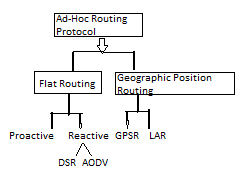 |
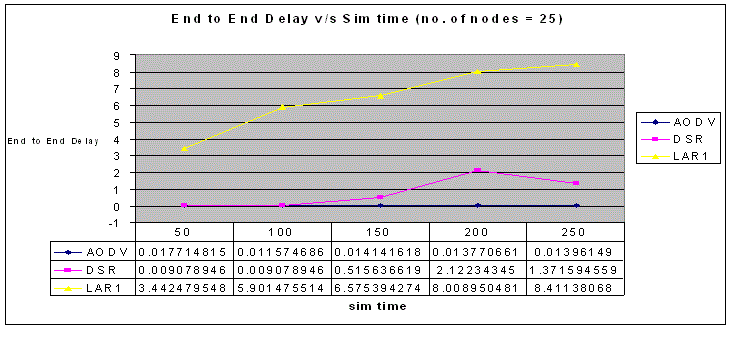 |
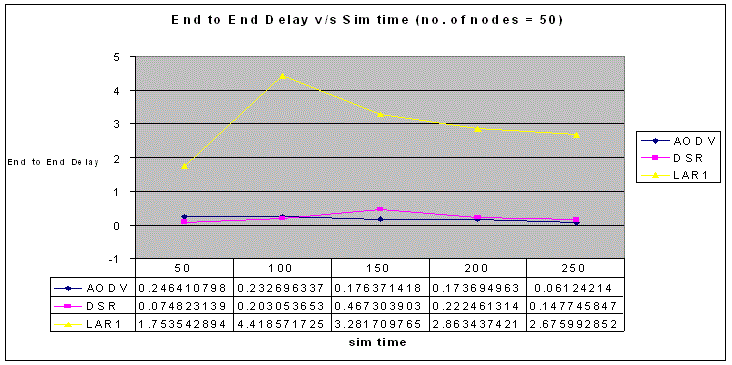 |
| Figure 1 |
Figure 2 |
Figure 3 |
|
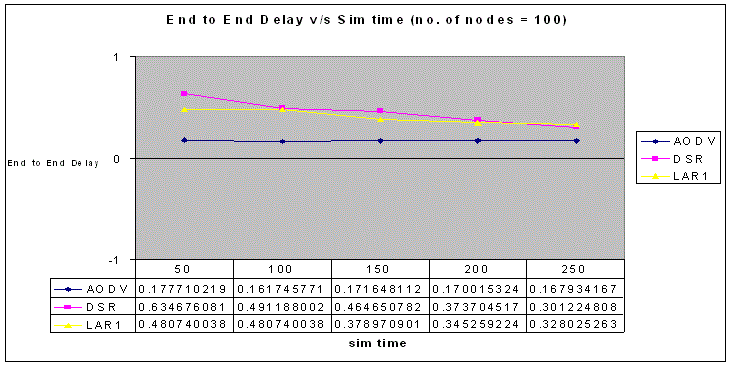 |
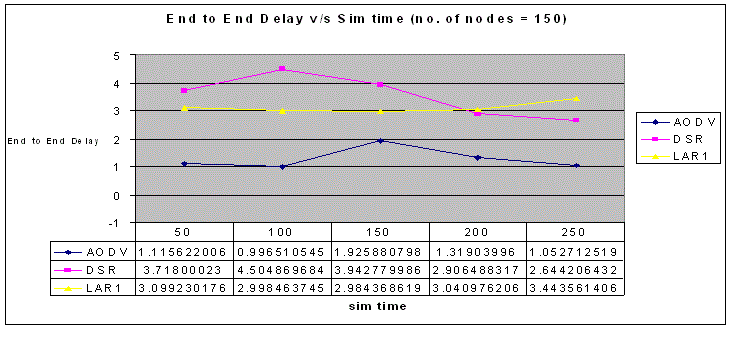 |
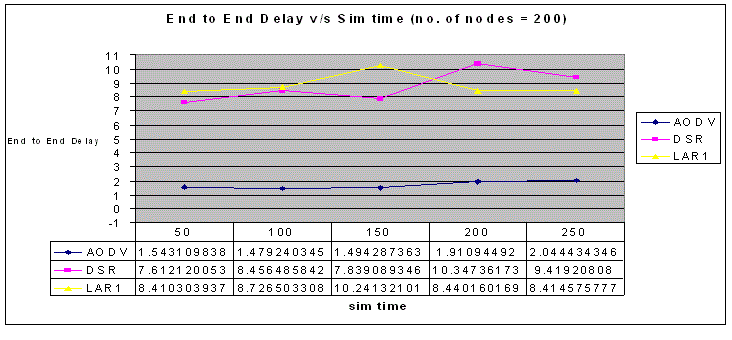 |
| Figure 4 |
Figure 5 |
Figure 6 |
|
References
- Amit N. Thakare, Mrs. M.Y.Joshi, âÃâ¬ÃÅPerformance Analysis of AODV & DSR Routing Protocol in Mobile ad-hoc NetworksâÃâ¬ÃÂ, IJCA special issue on âÃâ¬ÃÅMobile Ad-hoc NetworksâÃâ¬Ã MANETs, 2010.
- GeethaJayakumar and Gopinath Ganapathy, âÃâ¬ÃÅPerformance Comparison of Mobile Ad-hoc Network Routing ProtocolâÃâ¬ÃÂ, International Journal of Computer Science and Networks Security (IJCSNS), VOL.7 No.11, pp. 77-84, November, 2007.
- Mobile Ad-hoc Networks (MANETs) Working Group(2004), http://www.ietf.org/html.characters/MANETs-character.html.
- Krishna Gornatala, âÃâ¬ÃÅRouting in Mobile Ad-hoc NetworksâÃâ¬ÃÂ, Umea University, Sweden ,June-2006..
- C. S. R. Murthy and B. S. Manoj, âÃâ¬ÃÅad-hoc Wireless Networks: Architecture and ProtocolsâÃâ¬ÃÂ, ch. Routing Protocols for ad-hoc Wireless Networks, pp. 299{364. Prentice Hall Communications Engineering and Emerging Technologies Series, New Jersey: Prentice Hall, Professional Technical Reference, 2004.
- Jeffery John Geevarghese, âÃâ¬ÃÅRouting in Mobile Ad-Hoc NetworksâÃâ¬ÃÂ.
- Nor Surayati Mohamed Usop, Azizol Abdullah, Ahmad Faisal AmriAbidin, âÃâ¬ÃÅPerformance Evaluation of AODV, DSDV, & DSR Routing Protocol in Grid EnvironmentâÃâ¬ÃÂ, IJCSNS International Journal of Computer Science and Network Security, VOL.9 No.7, (July, 2009).
- NatrajanMeghanathan âÃâ¬ÃÅA Location Prediction-Based Reactive Routing Protocol to Minimize the Number of Route Discoveries and Hop Count per Path in Mobile ad-hoc NetworksâÃâ¬Ã - Department of Computer Science, Jackson State University, Jackson, MS 39217, USA, (2010).
- Y. B. KO and N.H. Vaidya, âÃâ¬ÃÅLocation-aided routing (LAR) in mobile ad-hoc NetworksâÃâ¬ÃÂ, in: Proc. Of Mobicom'98, 1998.
|